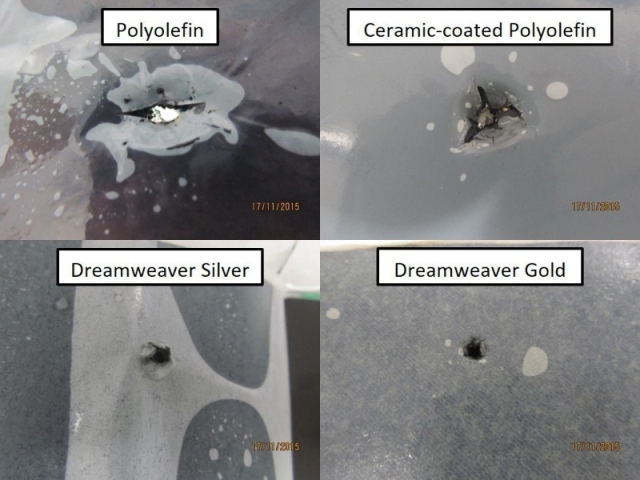Jan 13 2016
A team of investigators led by Dreamweaver International has investigated the effects of heat and nail penetration on lithium ion cells by performing autopsies on cells post-test. The investigators found that conventional separators shrink, melt, crack, split and burn under extreme conditions, while separators made of more thermally stable materials show much less damage, and in some cases none of these effects.
 Conventional battery separators shrink, melt, crack, split and burn under extreme conditions. Dreamweaver separators show much less damage and in some cases none of these effects. (PRNewsFoto/Dreamweaver International)
Conventional battery separators shrink, melt, crack, split and burn under extreme conditions. Dreamweaver separators show much less damage and in some cases none of these effects. (PRNewsFoto/Dreamweaver International)
Cells were built with identical construction except for the separators, and then several conventional safety tests were performed. The two most remarkable were a 170 C hot box and nail penetration. In the hot box cells made with conventional separators underwent thermal runaway, bursting the package and venting the electrolyte, while cells made with more thermally stable separators continued to hold their voltage for the full 1 hour duration and still functioned after the test.
The biggest surprises came with the nail penetration test, in which the cells made with ceramic coated polyolefin separator underwent immediate thermal runaway, the surface of the cell rising within two minutes to over 100 C, spilling smoke and electrolyte into the lab. The surface of the cells made with Dreamweaver Gold only rose to 40 C, and there was no evidence of electrolyte leakage or smoke.
These cells were then sent to Spectra Power, an independent battery facility, to be disassembled and investigated. "The most remarkable part of the cell autopsies was that the polyolefin separators in each cell stack were split, cracked, shrunk or burnt around the nail, while the Dreamweaver Gold showed only the physical damage of having a nail driven through the layers," said Jim Kaschmitter, CEO of Spectra Power, where the autopsies were performed.
"These investigations show that while a shutdown function may be attainable in thermal equilibrium, in a fast, dynamic thermal event such as those that might happen in an electric vehicle or a hoverboard, the shutdown often attributed to conventional separators will not uniformly turn the cell off. Portions at lower temperatures will still function and can deliver energy to other parts of the cell that will continue to overheat," said Professor Sungjin Cho of the Joint School of Nanoscience and Nanoengineering in Greensboro, NC.
"As Chief Engineer at two lithium ion battery companies, I have never seen a cell just do nothing for a half hour after a nail has penetrated the cell. Most explode or burn, and even the mild ones shoot smoke and gas out. But the cell made with Dreamweaver Gold just sat there. I believe we have found the solution to the lithium ion battery safety problem," said Carl Hu, former Chief Engineer at Enerdel and International Battery.